Arrests, hard labor, deportations to the east. To this day, it is impossible to count all those murdered during the "liberation" march of the Red Army. Especially since their new graves are still being discovered.
The Soviet security services and the Red Army units cooperating with them pursued the goal clearly defined by Stalin in Poland. They wanted to cleanse these lands of any anti-Soviet "elements". The Soviets took the first such actions before the Red Army units entered Polish soil.
Following the guidelines from Moscow, Soviet partisan units from the spring of 1943 carried out ruthless, bloody pacifications of Polish towns in the eastern borderlands. One of the most famous criminal actions took place on May 8, 1943 in Naliboki. The hammer and sickle bandits murdered 128 or 129 Poles in cold blood. The youngest victim was 10 years old.
The eyewitness Wacław Nowicki recalled that tragic event as follows:
What we saw when the guerrillas left was beyond human comprehension. Burnt out buildings. Heaps of corpses. Mostly gunshot wounds, shattered heads, bulging in terror, dead eyes. I saw a school friend among the dead. For the young boy I was then, it was a real shock. I will not forget this view for the rest of my life.
A similar feat was performed by the heroic "conquerors of fascists" on the night of May 28-29, 1944 in the village of Koniuchy. They literally wiped it off the face of the earth. They also killed at least 34 inhabitants, although some estimates put as much as 130 victims.
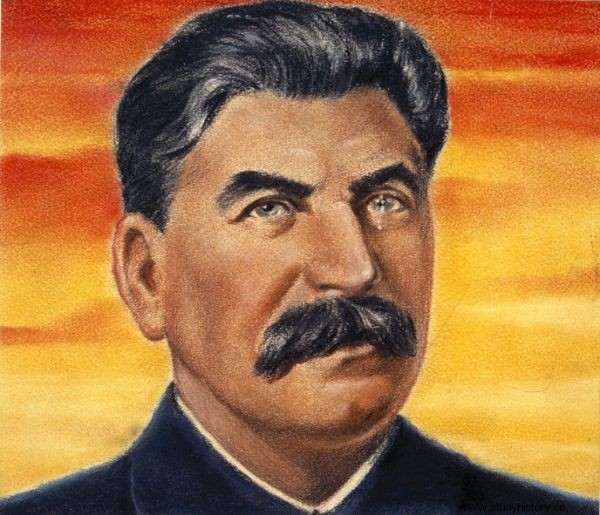
Stalin apparently agreed to create an independent, democratic Poland. However, the behavior of the Red Army in Poland indicated that it considered the country on the Vistula River as its sphere of influence.
They were often murdered in a bestial manner. They even burned several-year-old children alive. Interestingly, their commander, the Lithuanian communist Genrikas Zimanas, was awarded the Order of Virtuti Militari by the authorities of the supposedly "sovereign" PRL after the war.
Targeting the Home Army
However, the Soviets first of all wanted to eliminate the partisan units of the Home Army in the Borderlands. The unit commanded by Lieutenant Antoni Burzyński "Kmicic", operating in the area of Lake Narocz in the Vilnius Region, was the first to fire.
On August 26, 1943, "Kmicic" was tricked into the camp of Soviet partisans. They were commanded by Colonel Fyodor Markow, whom Burzynski knew before the war. On the spot, the Polish commander and the staff officers accompanying him were arrested. The same fate befell the rest of the squad as well. Antoni Burzyński and about 50 of his soldiers were shot, the rest was dissolved by the Soviets or incorporated into their unit.
Such actions, repeated by the Soviet partisans, met with a firm response from the Polish side. The Soviets were particularly affected by lieutenants Zygmunt Szendzielarz "Łupaszka" and Adolf Pilch "Góra", "Dolina". Nevertheless, it is estimated that about 1,000 members of the Polish underground were killed then in the Nowogród and Vilnius regions. In addition, about 500 Polish civilians were killed .
The fate of the unit of "Kmicic" foreshadowed what awaited our independence underground as soon as Red Army soldiers crossed the pre-war Polish border. The most striking example of this is the history of the soldiers of the Vilnius District of the Home Army.
The commander of the district, Lieutenant Colonel Aleksander Krzyżanowski "Wolf", had the possibility of establishing regular units of the Polish Army alongside the Red Army. Ultimately, he was treacherously arrested in the headquarters of general Ivan Czerniakhowski. Almost all of its officers also fell into the hands of the NKVD. About 8,000 Polish partisans were then captured. It is not known how many were killed in numerous skirmishes with the Soviet troops and the security services.
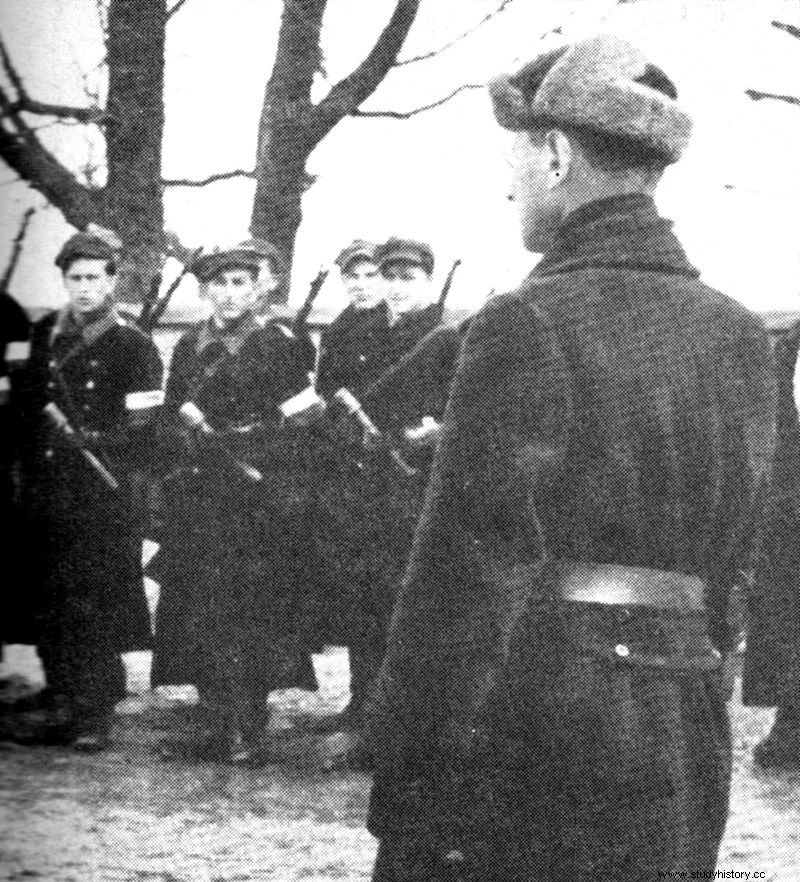
One of the victims of the Soviet "liberation" was Colonel Aleksander Krzyżanowski "Wolf" - pictured in front of the unit in January 1944.
In "Lublin Poland"
The Soviet terror against Poles did not abate at all after the Red Army crossed the Curzon Line. It was there that the "new, democratic Poland" funded by Stalin began.
Its foundations were laid by the figureheads anointed by the Red Tsar, appearing under the banner of the Polish Committee of National Liberation. They signed a scandalous agreement with the Soviet authorities in Moscow on July 26, 1944. They gave them all jurisdiction in the "liberated" territories of the Republic of Poland.
From that moment on, the local commanders of the Red Army could do whatever they liked with our citizens. The NKVD and Smiersz (military counterintelligence) eagerly exercised these powers. Prisons and camps, including those taken over from the Germans, were immediately filled with Polish prisoners .
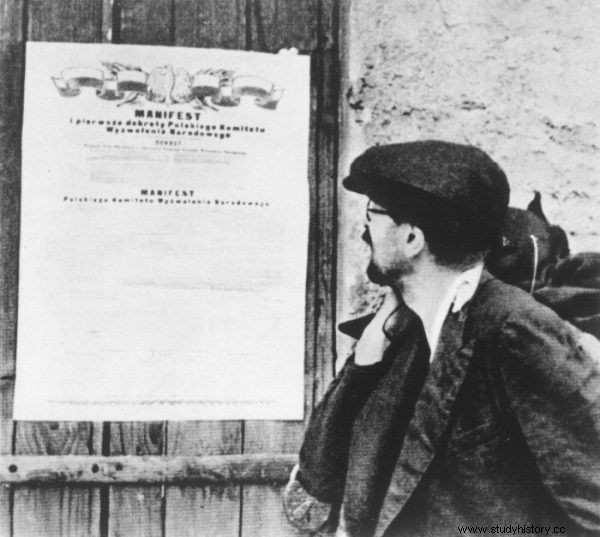
The Polish Committee of National Liberation announced the new order in the manifesto, announced on July 22, 1944. It soon became clear who is actually in power in Poland.
The history of Henryk Konowrocki "Gypsy", a Home Army soldier from Mińsk Mazowiecki, is typical for many members of our independence underground. This is how he recalls the backstage of his arrest by the Soviet security services in October 1944:
- Who is your commander?
- Mother and father - I answer - They rule me as they want.
The officer drew his pistol. On the side I got the butt of the pistol in my teeth. I got five of them. He asks again, "where are the guns?" I replied that I do not have. (...) They handcuffed us and took us to Cegłów, to a jail. There were already a lot of people from other places here. (...) During the interrogations, we were beaten and threatened with shooting, if we did not tell the truth.
The investigation lasted for several days. After its completion, Konowrocki and other prisoners were ordered to sign testimonies. They were in Russian with no translation. When the Poles refused to sign, the officers signed for them, adding only "he refused to sign". Then the "Gypsy" was brought before a Soviet court:
A mock judgment took place. The judges were:an officer, a non-commissioned officer and a Soviet soldier. It was called the "martial tribunal." Apart from me, my group included Zygmunt Padzik and Janek Sankowski. We both received the death penalty with Zygmunt, Janek Sankowski - 10 years under § 58 point 2 of the Code. Of the Criminal Soviet Union, which read:"an armed uprising against the Soviet system" .

One of the camps in which the NKVD held AK and NSZ soldiers was the camp in Rembertów. The photo shows a monument to the victims of the NKVD on the premises of the former Pocisk Ammunition Plant.
Konowrocki saved his life. Initially, he ended up in a prison in Orsza, where about 15 prisoners died every day due to terrible living conditions. Eventually, he ended up in Vorkuta, where he was forced to slave labor in the mines. He returned to Poland only after Stalin's death in 1954.
Of the approximately 50,000 Poles living in prisons and camps in the Soviet Union at the end of World War II, nearly half belonged to the Polish independence underground. The rest were members of the state administration, postal workers, railwaymen, foresters, teachers ... Anyone who was potentially hostile to the Republic of Poland created under the auspices of Stalin went there. It is not known how many of them remained there forever. Under extremely difficult conditions the number of deaths reached up to 45% of the initial number of prisoners .
Torture of the NKVD
Henryk Konowrocki was lucky that he did not go to a place like Trzebuska. Built in the middle of nowhere, the camp was called "Katyn near Rzeszów". Mainly the soldiers of the Polish resistance, who were tried by the Soviet military tribunal, were held there. The NKVD was executed by the NKVD in the nearby forest in Turza. Most of them were murdered with a shot to the back of the head. Sometimes their throats were slashed to save ammunition. The number of victims is estimated at around 300.
Another notorious place was the NKVD Headquarters in Poland. It was located at 8 Strzelecka Street in Warsaw. It was there that the executioner of the Polish independence underground, General Ivan Serov, was in office. The Home Army soldiers who were brought here were kept in the cellars. After brutal interrogations, they were sent to nearby Rembertów, where a transit camp was located before further transport to the east. Zygmunt Domański, staying at Strzelecka Street at the turn of February and March 1945, describes the ordeal of one of his fellow prisoners:
It was a real martyr hero. (...) During the investigation, demands were made to hand over the others, and he remained silent. For days, maybe even a week, he was beaten almost continuously, day and night; he would return to our basement for short pauses. His blood ran not only from his nose, mouth, ears, but simply from all orifices of his body . His sheepskin coat was taken from him, and in hellish so cold he lay in the basement between the two of us, covered only with our coats; his legs were so swollen from the beating that he had to go barefoot; There was no question of putting on your shoes.
Twice a day we were let out to the toilet with a hole in the floor. The poor man couldn't walk alone, so we were leading, or actually pulling our hands. (…) At night he was delirious and only whispered without stopping; it hurts, it hurts (...) the poor martyr died during the night. The corpse was not even brought into the world of God, but buried in the depths of the cellar.
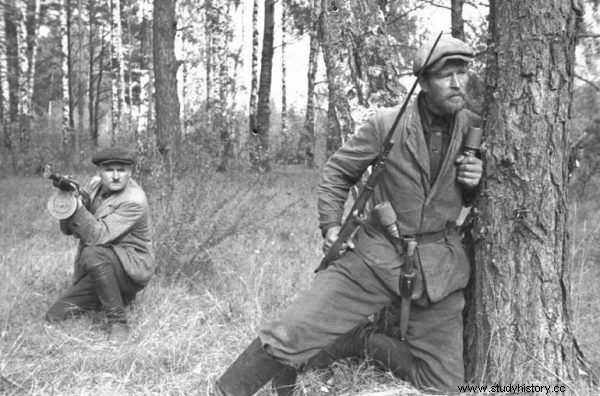
The Soviet partisan units that "liberated" Poland committed many crimes. The photo shows Soviet partisans in Belarus in 1943
The number of places where Polish patriots were detained and tortured in the first period after the "liberation" was found in today's Poland, about 550. This number includes both the NKVD, Smiersz and "native" security agencies. After all, they worked under the direct tutelage of their Soviet counterparts.
Bloody balance sheet of "liberation"
After the end of the war, in July 1945, an event unprecedented in history took place in Poland. On the territory of a formally independent country, the secret services and the army of a neighboring country carried out a great pacification operation . It is, of course, about the Augustów manhunt. In its course, Soviet units, carrying out many rapes and looting, detained and interrogated over 7,000 people. The fate of at least 592 of them is still unknown today.
How many lives of Polish patriots were absorbed by the Soviet "liberation" of our country from German occupation? The answer is not easy, because many matters related to this topic still remain unclear. In addition, the graves of the victims of those repressions are still found today.
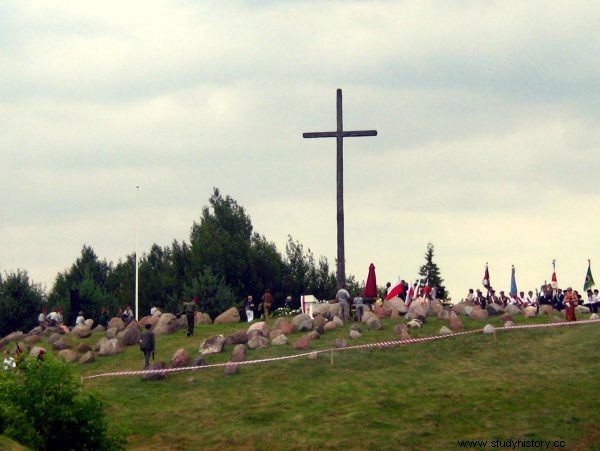
In order to commemorate the victims of the Augustów manhunt, a cross was erected in Giby (Podlasie province) with a symbolic grave of the missing.
Using the available data, the Institute of National Remembrance attempted to estimate the number of victims in the years 1944-1954. The employees of the Institute estimated that when "people's power" in Poland was installed and strengthened by the Soviet governors, 50,000 people could have been killed. For comparison, this is roughly the number of soldiers lost by the Home Army under the German occupation by the spring of 1944 .
It is worth remembering about the victims, all the more so as the Russian authorities and the apologists of the previous regime still remind us of the losses incurred in the fight against the German occupier. 400,000 Soviet soldiers were allegedly killed for Poland. Meanwhile, we also paid dearly for this "liberation" and this is the most precious thing for us. It was every drop of Polish blood shed by the "liberators" from the East.
***
Thanks to the book by Dariusz Kaliński entitled "Red Plague" you will learn the truth about the soviet "liberation" of Poland.
Bibliography:
- Anne Applebaum, Gulag , World of Books 2005.
- Aleksandra Arkusz, Polish citizens in the NKVD-MWD camp of the USSR No. 178-454 in Ryazan in 1944-1947 , "Historia Iagellonica" Publishing Society 2010.
- Artur Cegiełka, Break-up of the NKVD camp , Bulletin of the Institute of National Remembrance No. 4 (2009).
- Stéphane Courtois et al. , The Black Book of Communism. Crimes, terror, persecution , Prószyński i S-ka 1999.
- Piotr Gontarczyk, "Liberation" worse than the flood , Pamięć.pl No. 5 (2015).
- Teresa Kaczorowska, Augustów Raid , Bellona 2015.
- Michał Kalisz, Rzeszów Golgotha , Bulletin of the Institute of National Remembrance No. 4 (2009).
- Józef Krajewski, The wartime history of Vilnius 1939-1945. The fate of Poles, sensations, riddles , Bellona 2011.
- Kazimierz Krajewski, On lost posts. The Home Army in the Eastern Borderlands of the Second Polish Republic j, Wydawnictwo Literackie 2015.
- Henryk Konowrocki, Memoirs of a deported soldier of the Gray Ranks of the Home Army District , Minsko Mazowiecki Yearbook No. 1 (1997/1998).
- Tomasz Łabuszewski, In the footsteps of crime. A guide to places of communist repression in 1944-1956 , Institute of National Remembrance, Warsaw 2012.
- Grzegorz Motyka, A manhunt for white Poles. NKVD troops in the fight against the Polish underground 1944-1953, Wydawnictwo Literackie 2014.
